What Is The Difference Between Reach And Engagement On Facebook
For commitmentphobes, the word "engagement" might be a terrifying and loaded one — but for social media marketers, Facebook engagement is the holy grail.
Of course, we're not talking about popping the big Q: we're talking about growing your interactions (reactions, shares, comments) and audience for your Facebook Page.
Facebook engagement matters because it can help extend organic reach. Engagement helps boost your News Feed placement based on the Facebook algorithm.
Plus, likes and shares expose your posts to your audience's extended network.
Ultimately, engagement indicates that your audience is, well, engaged. And an engaged audience that wants to interact with your brand is something every marketer should aim for.
Bonus: Use our free engagement rate calculator to find out your engagement rate 4 ways fast. Calculate it on a post-by-post basis or for an entire campaign — for any social network.
What does engagement mean on Facebook?
Facebook engagement is any action someone takes on your Facebook Page or one of your posts.
The most common examples are reactions (including likes), comments and shares, but it can also include saves, viewing a video or clicking on a link.
How to increase Facebook engagement: 23 tips that work
1. Teach, entertain, inform, or inspire
Your Facebook audience is not looking for a sales pitch, and they're certainly not going to engage with one.
They want to engage with content that will make them smile, make them think or improve their lives in some way.
Plant delivery company Plantsome doesn't just post product pics, it shares lifestyle inspiration photos, too.
BRB ✌️ new WFH situation.Would you ever leave if your patio looked as good as @my_hygge_my_home
Posted by Plantsome on Monday, June 28, 2021
2. Get to know your audience
But here's the thing: what you find entertaining or inspiring is not always relevant.
When you're seeking engagement, it's the wants and needs of your audience that matter.
And it's tricky to understand what those wants and needs are unless you really understand who your audience is.
Facebook Page Insights provides a ton of useful information about your audience. Study this information carefully, and look for any unexpected details that could help you create a more meaningful connection with fans.
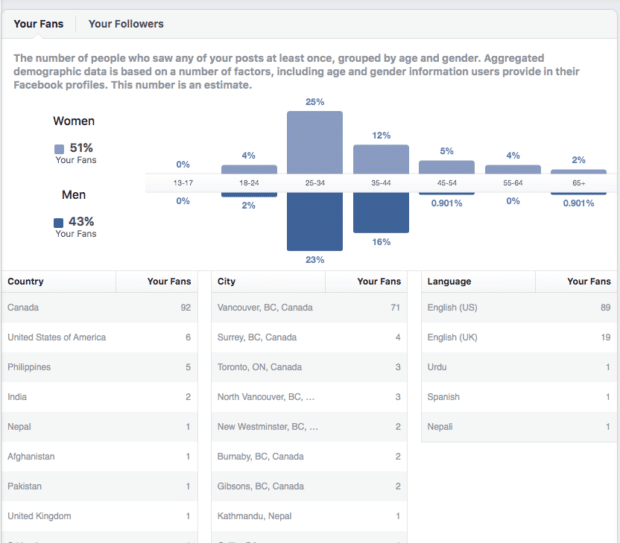
3. Keep it short
The vast majority of people use Facebook on their mobile devices—a whopping 98.3 percent of users.
Two sentences and a photo are all that this Vancouver music venue needed for their post. Keep your post short and sweet to capture attention quickly and entice users to stop scrolling and engage.
Thanks Amazon Music and Canadian Live Music Association for celebrating the love of live music with us! Check out the…
Posted by Fox Cabaret on Friday, July 9, 2021
4. Focus on quality
With people moving through content quickly, there's no time for sub-par graphics, videos or text.
If you're running out of original content to post, content curation can be a great way to share quality, informative content that gets your audience excited.
Pantone mixes things up by sharing colorful photography from shutterbugs every so often… like this lollipop pic.
Pops of color by Adam Hillman 🍭
Posted by Pantone on Thursday, July 1, 2021
Quality doesn't have to be complicated, or expensive. In fact, Facebook recommends keeping things simple with a consistent color scheme and recognizable images.
5. Be relatable and human
Whether it's sharing some behind-the-scenes content, presenting some honest and vulnerable emotions, standing up for your values or sharing a funny meme that acknowledges relatable experience, audiences are hungry for authenticity.
The UEFA football organization doesn't just post about the excitement of the game or hot pics of soccer players: it celebrates the real volunteers working outside of the spotlight to help make their tournaments happen.
👏 𝗩𝗼𝗹𝘂𝗻𝘁𝗲𝗲𝗿 𝗮𝗽𝗽𝗿𝗲𝗰𝗶𝗮𝘁𝗶𝗼𝗻 𝗽𝗼𝘀𝘁. 👏We're immensely proud of our team of volunteers across the 11 UEFA EURO 2020 host…
Posted by UEFA on Friday, July 9, 2021
Don't be afraid to get a little intimate or raw with your content — in some cases, being overly polished can actually feel cold.
6. Use (great) images
Facebook posts that include a photo see higher-than-average engagement rates. Simple shots work well. Facebook suggests a product close-up or a customer photo.
Candle brand Paddywax posts a mix of product shots and lifestyle shots, but everything is well lit, well framed and visually striking.
Ok call us crazy, but we kinda think yellow is the most underrated color? Especially when it's surrounded by other bright colors and filled with Paddywax fragrance!
Posted by Paddywax Candles on Wednesday, June 9, 2021
You don't need a fancy camera or photography equipment—your mobile phone is all you need to get started. This guide to taking better Instagram photos has tips that are just as applicable to Facebook.
If you're not confident in your photography skills, or you'd simply like to use photos taken by professionals, stock photography is a great option. Check out our list of free stock photo sites to find some great photo resources for your next post.
7. Make a video or broadcast live
Video posts see even higher engagement than photo posts. Like photography, videography can be simple and inexpensive, and you can get started using your mobile phone.
Even a short, atmospheric video like this one from Glossier can catch the eye of a rampant scroller.
Facebook Live videos see the highest engagement of all, so incorporate a real-team broadcast (ideally with dogs involved, like this Helping Hounds Dog Rescue example) into your social strategy every once in a while.
Keep in mind that vertical video gives you the most screen real estate on mobile devices.
Importantly, Facebook's algorithm prioritizes native videos, so you'll get the best results when you upload your vids directly to the site, instead of sharing a link.
8. Ask a question
An interesting question is a great way to kick off an active comments thread. Here are some ideas to get you started.
- How do you [complete this action]?
- Why do you [like this event or brand]?
- Do you agree with [a notable statement, event, person, etc.]?
- What's your favorite [fill in the blank]?
Burger King asked fans to help name its sourdough starter in a caption to this video. (Still waiting for them to choose an answer but we like "Glen.")
You could also ask fans for information about what kind of content they want to see from you. Then, give them what they ask for. This targeted content will inspire even more engagement.
9. Respond to fans
If someone takes the time to comment on one of your posts, make sure to reply. No one likes being ignored, and fans who engage with your posts want you to engage in return.
Make sure you have a team in place to monitor and respond to all comments. Sometimes a simple comment back is all that's needed. Sometimes more action is required. If someone posts a question that requires a customer service response, direct them to your CS channels or have an appropriate person follow up. ModCloth is always on the ball.
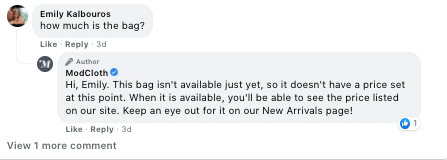
10. Test and measure everything
You know how the saying goes about what happens when you assume. On Facebook, there are tons of opportunities to learn what your fans like, and what they don't.
The statistics say that video posts get the most engagement, but that might not be true for your particular brand. Or maybe your followers just can't get enough 360-degree video.
Testing is such an important part of refining any marketing strategy that we've created a whole guide to show you how to do it right. Check out our step-by-step instructions on how to use social media for A/B testing.
Analytics is such an important part of the testing process. After all, if you're not measuring how those tests are going… what was the point? Here are four tools to use to collect that sweet, sweet Facebook data to know—quantitatively speaking—what's working best.
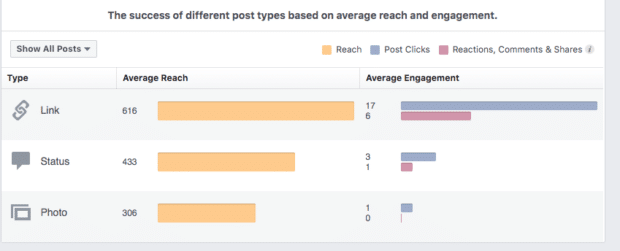
11. Post consistently and at the right times
Since the Facebook News Feed is based on an algorithm, your fans will not necessarily see your content the moment it's posted. Still, "when was this posted" is one of the signals for the Facebook algorithm. And Facebook itself says that you're more likely to see engagement if you post when your fans are online.
Bonus: Use our free engagement rate calculator to find out your engagement rate 4 ways fast. Calculate it on a post-by-post basis or for an entire campaign — for any social network.
Get the calculator now!
To find out the best times to post on Facebook, learn when your audience is active using Page Insights:
- From your Facebook Page, click Insights at the top of the screen
- In the left column, click Posts
- Click When Your fans Are Online
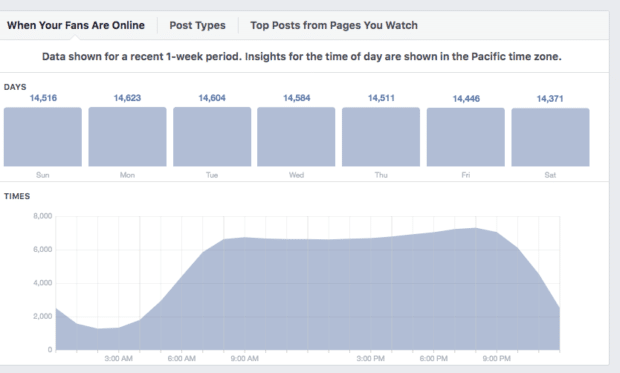
Times are shown in your local time zone. If your fans all seem to be active in the middle of the night, they're likely in a different time zone from you. To confirm, click People in the left column, then scroll down to see the countries and cities in which your fans and followers live.
Of course, that doesn't mean you need to get up in the middle of the night to post on Facebook. This is a great reason to schedule Facebook posts using a social media management tool.
The most important thing is to post consistently, so your audience comes to expect to see content from you regularly. Testing will help you determine how often you should post to get the best response from fans, but social media experts recommend posting at least two or three times per week.
12. Drive traffic from other sources
People who are already interacting with you on other channels are a great source of potential engagement. Make sure they know where to find you on Facebook.
Try adding a link to your Page on other social networks. Link to Facebook from your website and email signature — many companies (like The Cut) do this at the bottom of their website, or on their "About" page.

Include a Facebook plugin on your blog to highlight your latest posts, or embed a Facebook post directly in a blog post.
Don't forget about offline materials. Include your Facebook Page URL on your business cards, posters at events and packing slips.
13. Get active in Facebook groups
Creating a Facebook group is a great way to get fans involved and engaged. More than 1.8 billion people use Facebook groups. And those meaningful interactions in groups can create brand loyalty and lead to increased engagement on your Facebook Page.
Mixed Makeup has a private group for fans to share skincare tips and ask beauty questions — with over 64,000 members, it's a great example of community building.
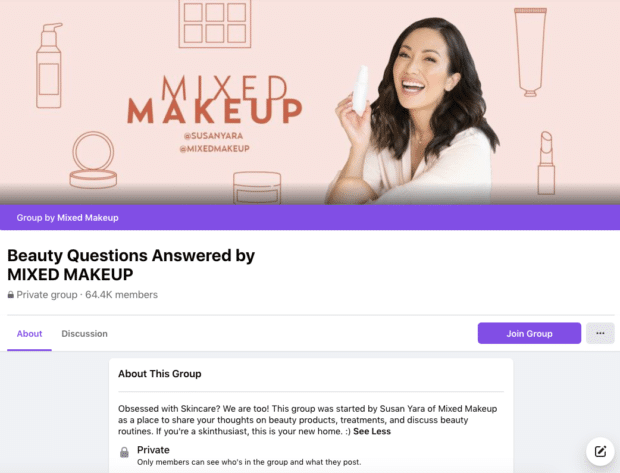
Joining other relevant Facebook groups is also a great way to connect with fellow entrepreneurs and thought leaders in your industry.
14. Use Facebook Stories
Like Instagram Stories, Facebook Stories appear at the very top of the News Feed. That's great placement for drawing eyeballs to your content — especially considering that 500 million people use Facebook stories daily.
This informal way of sharing content allows you to post as often as you like, without worrying about overwhelming your fans' News Feeds. And since people expect production quality to be lower on Stories, you can be more personal and in-the-moment to build a stronger personal connection with followers.
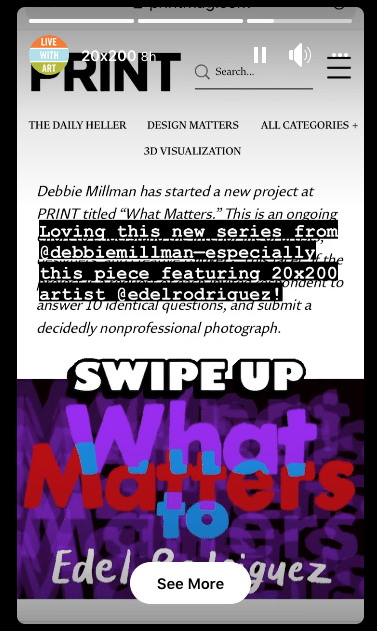
Source: 20×200
That stronger connection builds a desire to see more of your content, making followers more likely to check out—and engage with—the content posted on your Page.
15. Add a call-to-action button
A call-to-action button on your Page gives people Facebook engagement options beyond liking, sharing, and commenting.
Eye Buy Direct, for instance, has a "Shop Now" button to drive traffic for its slick specs.
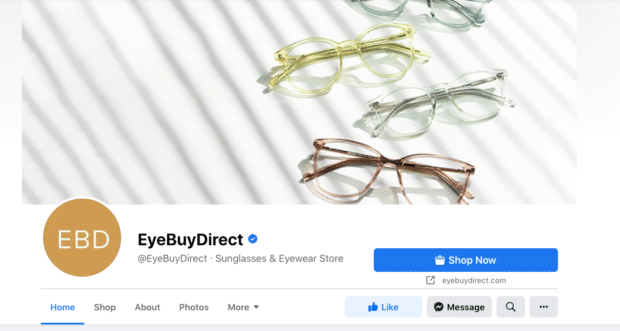
Your CTA button can ask viewers to:
- Book an appointment
- Contact you (including through Facebook Messenger)
- Watch a video
- Click through to your website
- Shop your products or see your offers
- Download your app or play your game
- Visit and join your Facebook group
16. Get verified
People want to know who they're talking to online. This applies to brands, too. A verified badge shows visitors that you're the real deal and they can feel safe engaging with your posts.
We can trust that anything this Showtime account, for example, is coming directly from the network. (Thank goodness! No lies about Ziwe over here!)
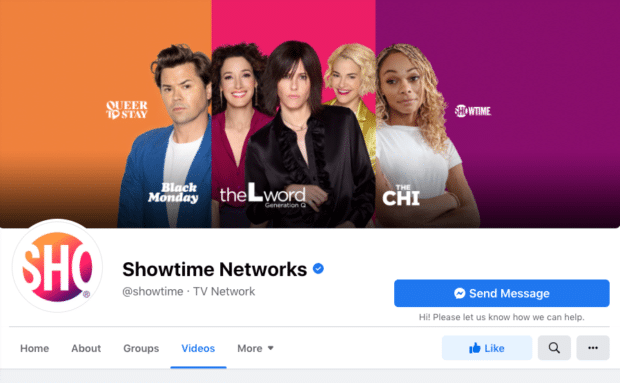
After all, no one wants to be the one to like or share a post from a fake Page misrepresenting a brand.
17. Avoid engagement bait
When you're hoping for likes and shares, it might be tempting to ask for likes and shares. Don't do it! Facebook considers this engagement bait and will penalize you by downranking your posts in the Facebook algorithm.
As mentioned above, it's fine to ask a genuine question, or ask your followers for their opinion or feedback. You cross the line when you ask for a comment that doesn't indicate any real thought or consideration.
React baiting, comment baiting, share baiting, tag baiting and vote baiting are all considered faux pas.
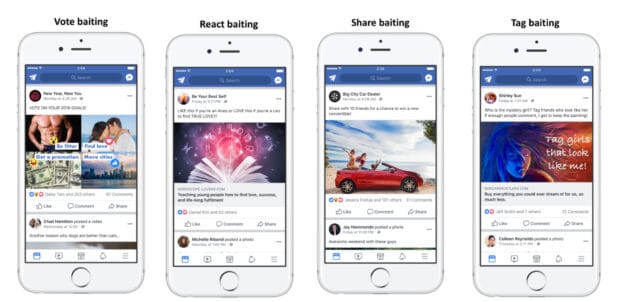
Source: Facebook
18. Boost your Facebook posts
Boosting a post is a simple form of Facebook advertising that allows you to get your post in front of more people, and thereby increase your chances of engagement.
Want more details? Check out our full guide to using the Facebook Boost Post button.
19. Join a trending conversation
Piggybacking on major events or trending hashtags is a great way to diversify your Facebook content and show that your brand has some range.
Speaking of pigs: even Peppa was getting in on the trending Suez Canal news when that was the hot topic of internet gossip.
Fortunately, Mr Bull was available this weekend. 👷♂️#Evergiven #suezcanal
Posted by Peppa Pig on Monday, March 29, 2021
20. Get a little help from your friends (or employees, or influencers)
When people share your content, that's a hint to Facebook that this is the good stuff. So encouraging your team, family or friends to share your posts with their own network doesn't just get you in front of their followers: it helps boost you in the newsfeed for everyone.
Some brands use an employee advocacy program to accomplish this. Another option for spreading your reach is to team up with ambassadors, influencers or partners — though this would likely be a paid endeavor.
21. Run contests
Surprise! People love free stuff. Giveaways and competitions are a great way to get people excited to engage and follow your Page. Check out our tips for running a successful Facebook contest here.
That being said, Facebook does have some regulations around contests on its site (and your region or country might, too!) so make sure to familiarize yourself with the rules before you start handing out the grand prizes.
Want to win one of five $100 The Body Shop e-gift cards? Head on over to our Instagram account…
Posted by The Body Shop on Thursday, July 8, 2021
22. Scope out the competition
Keeping an eye on what your nemesis is up to is a way to make sure you're not left behind or missing out on something that's working well.
Setting up a stream in your Hootsuite dashboard to monitor industry Pages or search for industry hashtags or topics is a great way to keep yourself in the loop about what competitors are up to.
23. Repackage successful content
If a post worked well, don't just pat yourself on the back and call it a day… start brainstorming about how you can repackage that winning content and get a bit more out of it.
For instance, if a how-to video is a hit, can you spin a blog post out of that? Or repost a link with a brand new photo and a compelling question?
Of course, you'll want to spread those posts out — maybe by a few weeks — so it's not obvious you're repeating yourself.
How to calculate your Facebook engagement rate
Engagement rate is a formula that measures the amount of interaction social content earns relative to reach or other audience figures. This can include reactions, likes, comments, shares, saves, direct messages, mentions, click-throughs and more (depending on the social network).
There are multiple ways to measure engagement rate, and different calculations may better suit your social media objectives.
You can measure engagement by reach, engagement rate by posts, engagement rate by impression, and on and on.
For the specific formula for six different engagement rate calculations, check out our engagement rate calculator and crunch those numbers.
With these tips, you should be ready to tackle Facebook like a pro. If you're still hungry for ideas to grow your other social channels, check out our post on increasing social media engagement here!
Manage your Facebook presence alongside your other social media channels using Hootsuite. From a single dashboard, you can schedule posts, share video, engage your audience, and measure the impact of your efforts. Try it free today.
Get Started
Easily manage your Facebook page (+ other social media accounts) and save time with Hootsuite. Schedule, engage, analyze, perform.
Try it for Free
What Is The Difference Between Reach And Engagement On Facebook
Source: https://blog.hootsuite.com/increase-facebook-engagement/
Posted by: shepardthalow.blogspot.com

0 Response to "What Is The Difference Between Reach And Engagement On Facebook"
Post a Comment